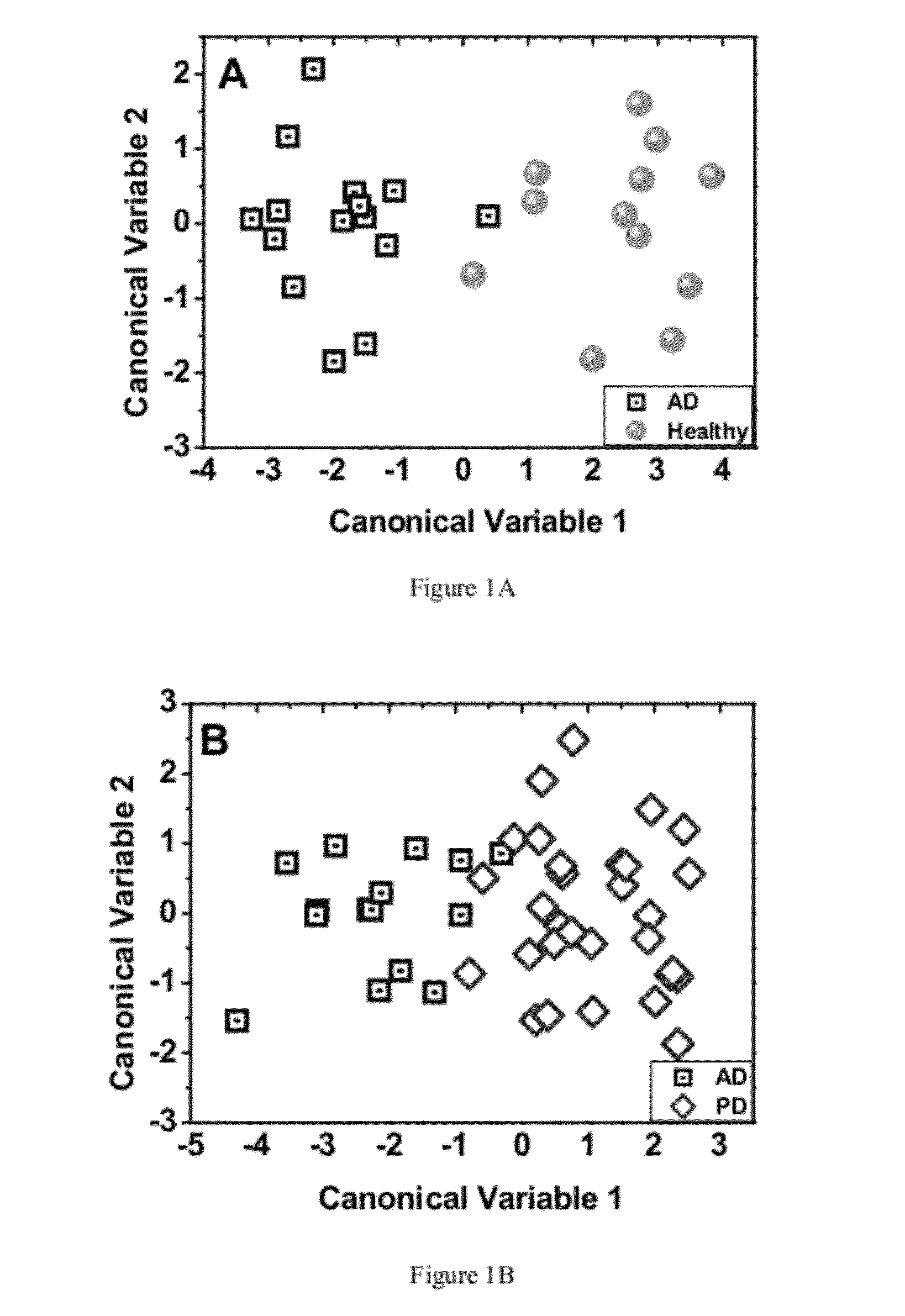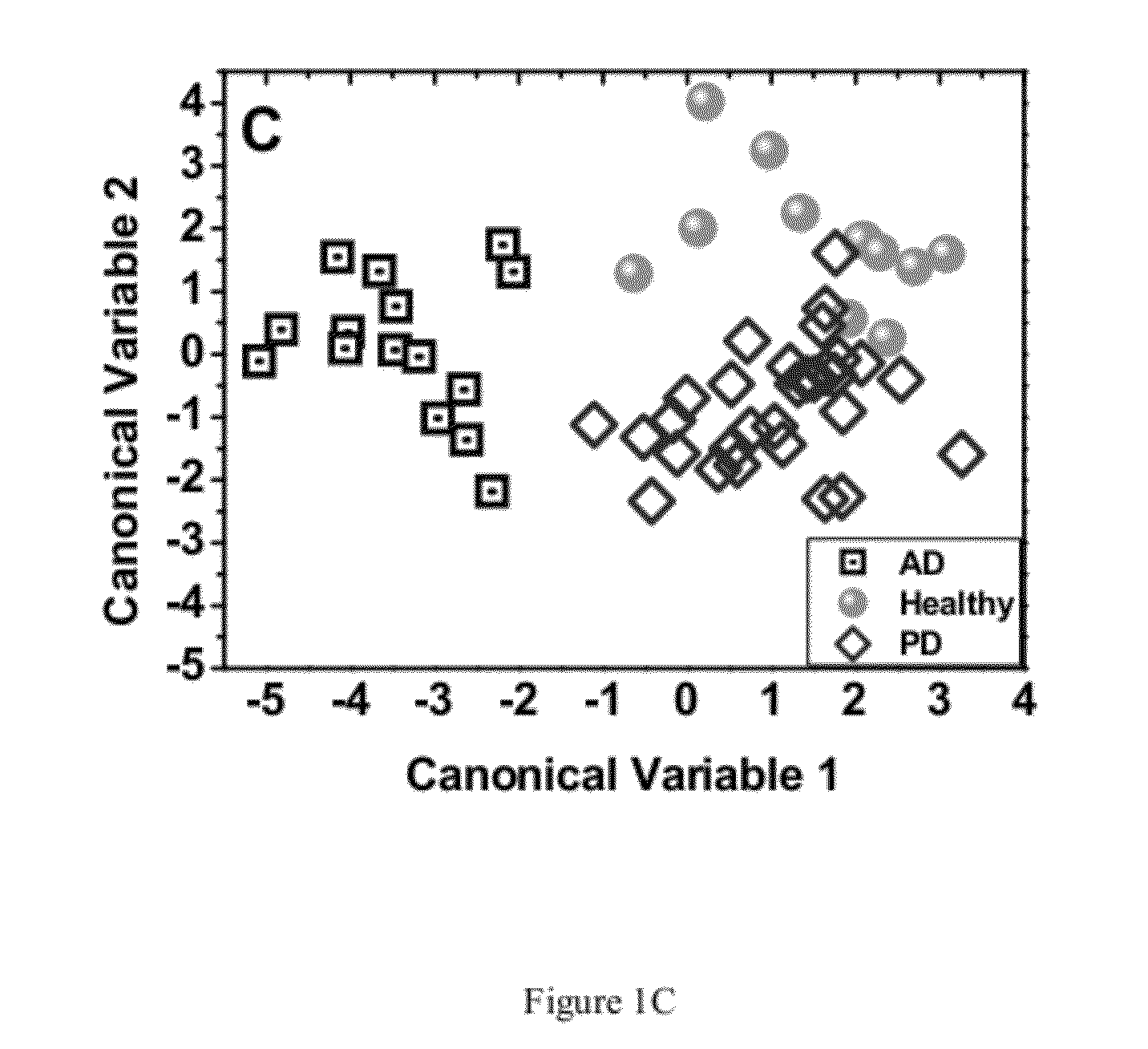Method of diagnosing, prognosing and monitoring alzheimer's disease
a technology of alzheimer's disease and breath analysis, applied in the field of system and methods for diagnosis, prognosis and monitoring of alzheimer's disease through breath analysis, can solve the problem that no biochemical tests are known for the diagnosis
- Summary
- Abstract
- Description
- Claims
- Application Information
AI Technical Summary
Benefits of technology
Problems solved by technology
Method used
Image
Examples
example 1
Test Population
[0088]The test population included 57 non-smoking volunteers (15 AD patients, 30 PD patients and 12 healthy controls) at the age of 37-85. The AD patients were recruited from the out-patient population of the Cognitive Unit, Rambam Health Care Campus (Haifa, Israel). The control group of PD patients (Hoehn and Yahr stages 1-4; Goetz et al., Mov. Disord., 2004, 19, 1020-1028; Hoehn et al., Neurology, 1967, 17, 427-442) was recruited from out-patients of the Department of Neurology and the Cognitive Unit of the Rambam Health Care Campus and the healthy controls were recruited from the patients' accompanying persons. The AD and PD patients were diagnosed through assessment of clinical symptoms in the aforementioned specialist clinics and the healthy controls were declared healthy (not afflicted with AD or PD) in the same specialist setting. All AD patients were medicated, but medication varied between patients. A summary of the patient characteristics is provided in Tabl...
example 2
[0090]The clinical study was cross-sectional. Highly accurate diagnosis was achieved through clinical examination in a specialist clinic and served as reference standard. The tested AD patients were compared with two test groups, healthy controls and PD patients. Patterns of volatile biomarkers for the three test groups were obtained by comparing (i) AD patients and healthy controls, (ii) AD patients and PD patients, and (iii) all three test groups together. All subjects who were included in this study were non-smokers. One male AD patient was excluded after recruitment because of his long-time heavy smoking habits. The three test groups were approximately age matched. The gender ratio of the AD patients was similar to that of healthy controls but was different form that of the PD control group. This relaxation of the recruiting criteria is acceptable, since the sensors that were used to detect volatile biomarkers' patterns have been specially tailored to show little s...
example 3
Breath Collection
[0091]Exhaled alveolar breath was collected in a controlled manner from AD patients and from control subjects in the hospital environment. The inhaled air was cleared of ambient contaminants by repeatedly inhaling to total lung capacity for 3-5 minutes through a mouthpiece (purchased from Eco Medics, Duerten, Switzerland) that contained a filter cartridge on the inspiratory port, thus greatly reducing the concentration of exogenous volatile organic compounds and removing 99.99% of the exogenous compounds from the air during inspiration. Since some typical hospital contaminations might be present in very large concentrations (Amann et al., Euro. Resp. Soc. Monograph, 2010, 49, 96-114), the unfiltered hospital air was also sampled. GC-MS in conjugation with Solid-Phase Micro-Extraction (SPME) found the following typical hospital contaminants: 2-methyl-2-propanol, ethanol and methyl-isobutyl-ketone. Trace amounts of these compounds were identified in less than 23% of t...
PUM
 Login to View More
Login to View More Abstract
Description
Claims
Application Information
 Login to View More
Login to View More - R&D
- Intellectual Property
- Life Sciences
- Materials
- Tech Scout
- Unparalleled Data Quality
- Higher Quality Content
- 60% Fewer Hallucinations
Browse by: Latest US Patents, China's latest patents, Technical Efficacy Thesaurus, Application Domain, Technology Topic, Popular Technical Reports.
© 2025 PatSnap. All rights reserved.Legal|Privacy policy|Modern Slavery Act Transparency Statement|Sitemap|About US| Contact US: help@patsnap.com



